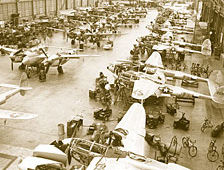Mobilization for Total War
The nation rapidly geared itself for mobilization of its people and its entire industrial capacity. Over the next three-and-a-half years, war industry achieved staggering production goals -- 300,000 aircraft, 5,000 cargo ships, 60,000 landing craft, 86,000 tanks. Women workers, exemplified by "Rosie the Riveter," played a bigger part in industrial production than ever before. Total strength of the U.S. armed forces at the end of the war was more than 12 million. All the nation's activities -- farming, manufacturing, mining, trade, labor, investment, communications, even education and cultural undertakings -- were in some fashion brought under new and enlarged controls.

Assembly line of P-38 Lightning fighter planes during World War II. With its massive output of war materiel, the United States became, in the words of President Roosevelt, "the arsenal of democracy."
(Lockheed)
As a result of Pearl Harbor and the fear of Asian espionage, Americans also committed what was later recognized as an act of intolerance: the internment of Japanese Americans. In February 1942, nearly 120,000 Japanese Americans residing in California were removed from their homes and interned behind barbed wire in 10 wretched temporary camps, later to be moved to "relocation centers" outside isolated Southwestern towns.
Nearly 63 percent of these Japanese Americans were American-born U.S. citizens. A few were Japanese sympathizers, but no evidence of espionage ever surfaced. Others volunteered for the U.S. Army and fought with distinction and valor in two infantry units on the Italian front. Some served as interpreters and translators in the Pacific.
In 1983 the U.S. government acknowledged the injustice of internment with limited payments to those Japanese Americans of that era who were still living.
